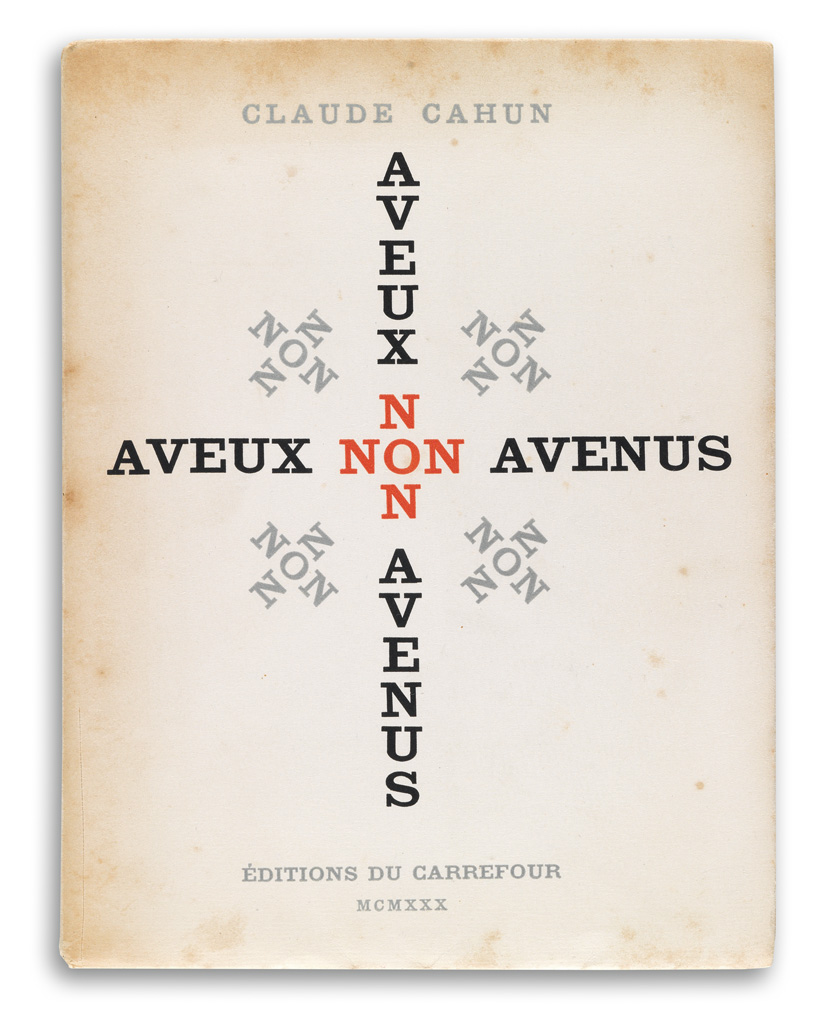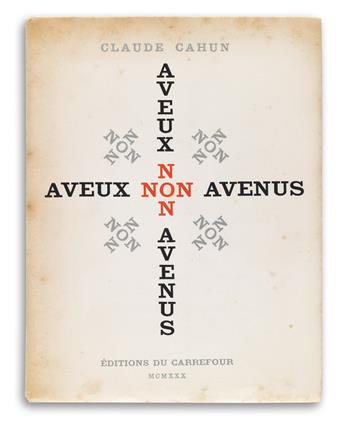Sale 2385 - Lot 179
Unsold
Estimate: $ 4,000 - $ 6,000
CAHUN, CLAUDE.
Aveux non Avenus.
Preface by Pierre Mac Orlan. Illustrated with 10 reproductions of photo-collages composed by Marcel Moore (Suzanne Malherbe) after photographs by Cahun, comprising the only self-portrait Cahun published during her lifetime. 8vo, printed white dust jacket over wrappers, lightly foxed, with remnants of original glassine on rear panel; ex-library hand stamp of Marcel Bekus on the inside front panel, endpapers discolored. Roth 62; Hasselblad 92. one of 500 numbered copies, this signed by cahun (and with an erased inscription).
Paris: Éditions du Carrefour, (1930)
Aveux non Avenus.
Preface by Pierre Mac Orlan. Illustrated with 10 reproductions of photo-collages composed by Marcel Moore (Suzanne Malherbe) after photographs by Cahun, comprising the only self-portrait Cahun published during her lifetime. 8vo, printed white dust jacket over wrappers, lightly foxed, with remnants of original glassine on rear panel; ex-library hand stamp of Marcel Bekus on the inside front panel, endpapers discolored. Roth 62; Hasselblad 92. one of 500 numbered copies, this signed by cahun (and with an erased inscription).
Paris: Éditions du Carrefour, (1930)
Additional Details
A scarce, signed copy of this important surrealist publication. In 1917 a young French artist named Lucie Schwob decided to reinnvent herself and assumed the gender-neutral pseudonym, Claude Cahun. She lived openly with Suzanne Malherbe (Marcel Moore), who was her friend, companion, stepsister, collaborator, and paramour. In Paris, this prominent young couple became the driving force in the intellectual and artistic surrealist community during the years between the wars.
Cahun's photobook reflects surrealist artists' association with dream-like subcconsious forms. The personal narrative features Cahun as both subject and object in "a compendium of reveries, aphorisms, and enigmatic intimacies on love and self-knowledge." She employed elaborate photomontages to demarcate individual chapters. Within this dense imagery, earlier self-portraits interact with other visual imagery, creating a fragmented flurry of narcissism and personal identification throgh disjointed and multiple presentations of the female body.
Cahun had no single identity, but an understanding of her self may be found in each of her personas. The feminist writer Simone de Beauvoir understood Cahun's multiple self-creations as a distinctly female issue. In her magnum opus "The Second Sex" she states, "But all her life the woman is to find the magic of her mirror a tremendous help in her effort to project herself and then attain self-identification. . . man's body does not seem to him an object of desire, while woman, knowing and making herself object, believes she really sees herself in the glass."
From the library of Marcel Bekus (1888-1939), an antiquarian book collector and historian who specialized in titles devoted to the Russian revolution and Socialism, and who participated in the 1917 Revolution. Laid in is the original Priére D'Insérer (Prospectus).
Cahun's photobook reflects surrealist artists' association with dream-like subcconsious forms. The personal narrative features Cahun as both subject and object in "a compendium of reveries, aphorisms, and enigmatic intimacies on love and self-knowledge." She employed elaborate photomontages to demarcate individual chapters. Within this dense imagery, earlier self-portraits interact with other visual imagery, creating a fragmented flurry of narcissism and personal identification throgh disjointed and multiple presentations of the female body.
Cahun had no single identity, but an understanding of her self may be found in each of her personas. The feminist writer Simone de Beauvoir understood Cahun's multiple self-creations as a distinctly female issue. In her magnum opus "The Second Sex" she states, "But all her life the woman is to find the magic of her mirror a tremendous help in her effort to project herself and then attain self-identification. . . man's body does not seem to him an object of desire, while woman, knowing and making herself object, believes she really sees herself in the glass."
From the library of Marcel Bekus (1888-1939), an antiquarian book collector and historian who specialized in titles devoted to the Russian revolution and Socialism, and who participated in the 1917 Revolution. Laid in is the original Priére D'Insérer (Prospectus).
Exhibition Hours
Exhibition Hours
Aliquam vulputate ornare congue. Vestibulum maximus, libero in placerat faucibus, risus nisl molestie massa, ut maximus metus lectus vel lorem.






